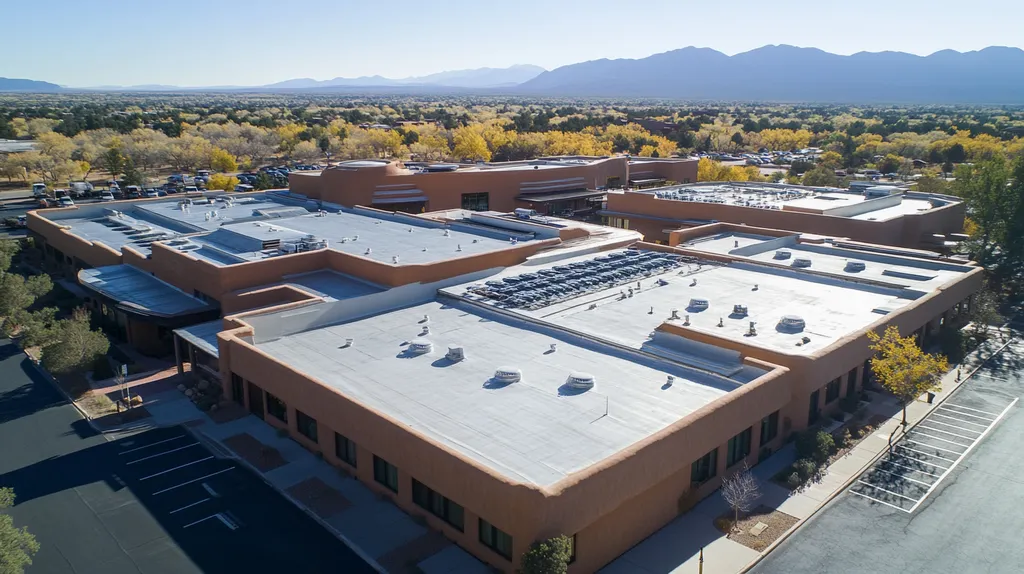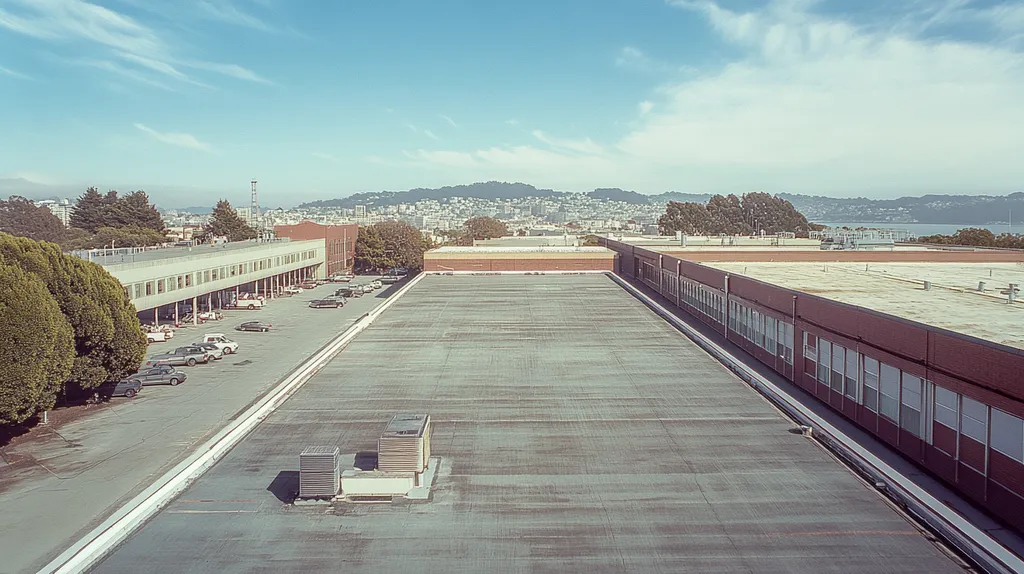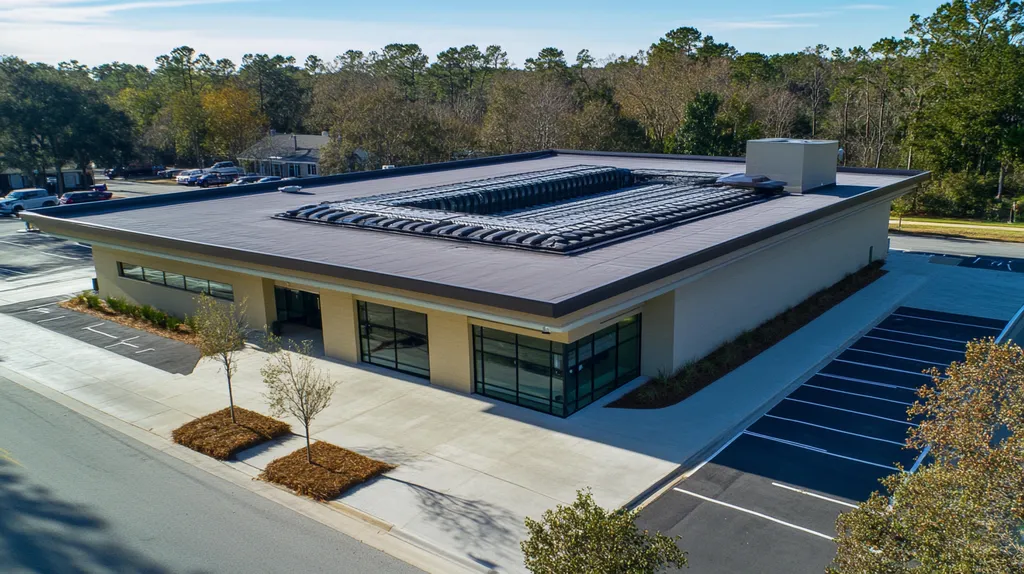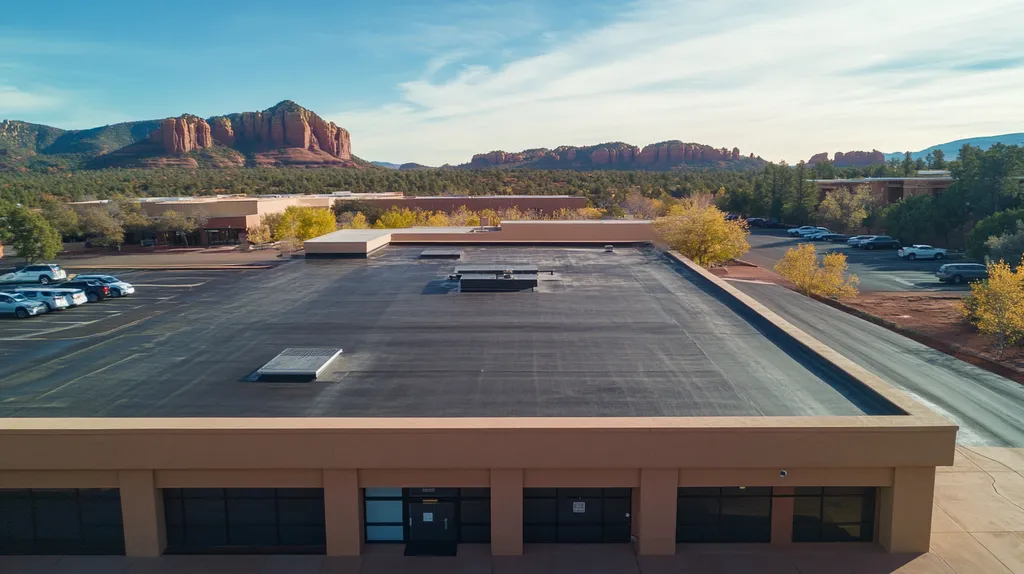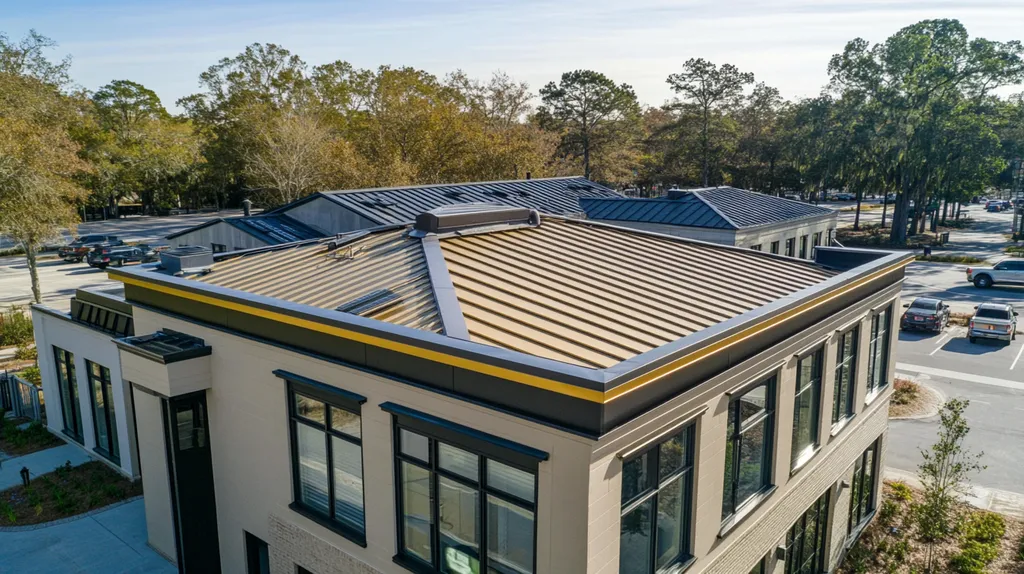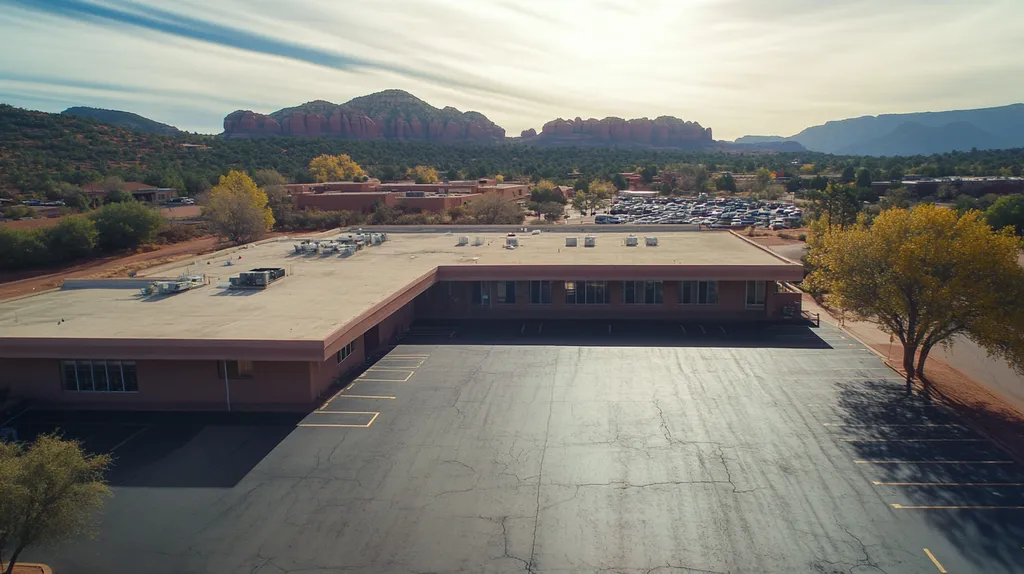Commercial roof coatings represent a $1.5 billion annual investment across U.S. properties, yet studies indicate up to 40% fail prematurely due to misunderstood lifespan expectations.
While manufacturers commonly promote 10-20 year durability ratings, real-world performance often falls dramatically short due to systemic issues in material selection, application methods, and maintenance practices.
This analysis examines how conventional assumptions about coating longevity lead to costly oversights, while providing evidence-based solutions for maximizing roof coating performance through enhanced protocols and data-driven decision making.
SECTION 1: CURRENT PRACTICES
Understanding the current practices surrounding commercial roof coatings is crucial for property owners and facility managers. While many coatings boast lifespans of 10-20 years, misconceptions about their actual performance often lead to costly mistakes. These misassumptions can prompt unnecessary early replacements and inflate maintenance budgets. A solid grasp of application methods, material options, and maintenance routines can greatly extend the value and longevity of these roofing systems.
Standard Application Methods
Applying commercial roof coatings requires careful attention to detail, involving multiple layers for optimal adhesion and durability. Standard practices cover essential steps like thorough surface preparation, priming, and the precise application of the coating. Skipping or inadequately performing any of these steps can significantly shorten the roof’s effective lifespan.
One popular application method is spray application, known for its ability to provide uniform coverage. However, it demands skilled labor to avoid issues such as overspray or uneven thickness. Roll-on techniques are often used for smaller sections, but they may not achieve the same level of thickness that spray applications provide. Thus, the choice of application method plays a crucial role in the coating’s durability and overall performance.
Additionally, environmental factors during application can impact the results, with variations affecting adhesion and curing times. Strict adherence to manufacturer guidelines is essential to prevent these potential pitfalls. By understanding the intricacies of various application techniques, property owners and managers can make informed decisions that enhance the effectiveness and lifespan of their roof coatings.
Incorporating modern application best practices can result in superior roofing outcomes, while neglecting to adapt can lead to wasted materials and financial losses.
Common Material Choices
The choice of materials for roof coatings can vary significantly, impacting both performance and durability. Common options include acrylics, silicones, and polyurethanes, each with particular advantages and drawbacks. For instance, acrylic coatings are cost-effective and provide decent UV resistance but may struggle in areas prone to standing water.
Silicone coatings are celebrated for their exceptional water resistance, although they often come with a higher initial cost. On the other hand, polyurethanes offer high durability, but they may lack adequate UV protection. This variety can create confusion for property managers tasked with balancing costs, longevity, and overall performance.
Choosing the wrong material can accelerate wear and require earlier replacement or additional repair investments. It’s vital for property owners to assess their roofing conditions thoroughly before selecting coating materials. Making informed choices regarding materials not only enhances performance but also protects financial investments in roofing systems.
Ultimately, awareness of the diverse material options is essential for optimizing roofing system investments and achieving long-term success.
Typical Maintenance Routines
Implementing a regular maintenance routine is essential for extending the lifespan of commercial roof coatings. Many property owners mistakenly believe that once a coating is applied, it needs little upkeep. However, systematic inspections and maintenance are required to identify and fix small issues before they evolve into major, costly repairs.
Standard maintenance practices include conducting visual inspections, removing debris, and checking for cracks or blisters that could undermine performance. It’s also important to synchronize maintenance efforts with seasonal changes, as varying weather conditions can greatly affect coating integrity.
Employing preventive measures, such as applying maintenance coatings at regular intervals, can bolster protective layers. Ignoring maintenance responsibilities can lead to water intrusion and, eventually, structural damage, adversely affecting the roofing system’s lifespan.
Establishing a consistent maintenance schedule not only prolongs the life of roof coatings but also promotes early detection of potential issues. By prioritizing maintenance activities, property owners can effectively safeguard their valuable roofing investments.
SECTION 2: SYSTEMIC ISSUES
The lifespan of commercial roof coatings is frequently jeopardized by systemic issues that often go unrecognized until they escalate into costly repairs. A 2021 study revealed that improper installation techniques could reduce a roof’s expected lifespan by up to 40%. Property owners must be vigilant about these challenges, as they directly affect both financial outlays and safety. Addressing quality control, installation consistency, and environmental factors is crucial for safeguarding investments in roof coatings.
Inadequate Material Quality Control
A significant contributor to the reduced lifespan of roof coatings is inadequate quality control during the manufacturing process. Poorly formulated coatings can result in issues such as delamination and blistering, drastically cutting down lifespans and leaving property managers to cope with unexpected repair costs.
Often, manufacturers overlook strict quality control measures in their pursuit of cost savings. Without comprehensive testing for durability and weather resistance, materials fail to perform as promised. This oversight can lead to substantial financial burdens for property owners, who may find themselves needing replacements far sooner than projected.
In some instances, certifications for materials are outdated or disregarded, causing property owners to unknowingly utilize inferior products. The consequences can be severe; substandard materials may lead to systemic failures of the roofing system.
To minimize these risks, property owners should prioritize vendors that offer transparent testing data and industry-compliant certifications. Investing in high-quality materials can pay dividends in extending the lifespan of roof coatings and reducing overall maintenance costs.
Improper Installation Techniques
The quality of installation is another pivotal factor that can deeply influence the longevity of commercial roof coatings. Even the best materials can fail when misapplied. A lack of proper training for installation teams often leads to critical mistakes that threaten the integrity of the roofing system.
Common installation pitfalls include improper surface preparation and inadequate application of coating layers. These mistakes frequently arise from ignoring manufacturer guidelines or rushing to meet tight deadlines. Such negligence can compromise the adhesion crucial for the effectiveness of the coating.
Moreover, inexperienced installation crews may overlook environmental conditions during application, which can drastically affect performance. For example, coatings should never be applied in extreme temperatures or high humidity, as these conditions impair adhesion. Proper oversight of the installation process is vital to ensure adherence to established standards.
To mitigate installation-related risks, property owners are advised to engage experienced contractors who offer warranties that cover not only materials but also workmanship. Such guarantees provide additional security against premature coating failures.
Neglect of Environmental Factors
Environmental considerations play a significant role in determining the performance and lifespan of commercial roof coatings, yet they are often overlooked during material selection and installation. Coatings subjected to intense UV radiation deteriorate faster than those installed in shaded conditions.
Local weather patterns also impact coating longevity. For instance, regions with high humidity or frequent storms may experience accelerated degradation of roof coatings. Property owners must factor these elements into their material and application choices to ensure long-lasting protection.
Failing to consider environmental factors can lead to substantial long-term costs. A coating system that performs well in one location may fall short in another due to varying climatic stressors. Regular maintenance and inspections can help property managers assess how well their coatings hold up against local conditions.
Ultimately, understanding and addressing these environmental influences is essential for maximizing the durability and effectiveness of commercial roof coatings. Property owners should conduct thorough assessments of their environmental circumstances to make informed roofing decisions that safeguard their investments.
SECTION 3: MISSED OPPORTUNITIES
Property owners often unknowingly jeopardize the longevity of their commercial roof coatings by missing critical evaluation steps. Neglecting to assess the roof’s condition before a coating application can result in early failures and unexpected repair costs. Coatings promise to enhance the lifespan of roofs, but underlying issues like leaks or structural wear must be addressed first. Failing to take these factors into account can translate into wasted investments and elevated operational expenses.
Overlooking Roof Condition Pre-Coating
Thoroughly inspecting the roof’s condition before applying a coating is not just recommended; it is essential. Any existing damage—be it cracked seams, punctures, or other issues—must be repaired beforehand. If these problems are neglected, they can worsen over time, leading to a coating that fails prematurely.
For example, a flat roof with hidden moisture can trap water beneath the coating, causing blistering and delamination. Without a rigorous inspection, property owners may accidentally seal in existing problems, which can incur significant long-term maintenance costs.
Moreover, overlooking roof slope issues can result in water pooling, further accelerating deterioration. A comprehensive evaluation prior to coating application should address both visible damage and concealed problems.
By approaching this process proactively, property owners can ensure that the coating delivers its intended protective benefits and longevity, thereby safeguarding their investments while minimizing future expenses.
Ignoring Coating Thickness Variations
The application thickness of a roof coating plays a vital role in its overall durability and effectiveness. Yet, many facilities managers fail to monitor and control this critical aspect during installation. Inconsistent application can create weak spots vulnerable to degradation and environmental damage.
If a coating is applied too thinly in specific areas, it may not offer sufficient protection against weather-related elements, leading to rapid deterioration and necessitating early replacement.
Conversely, oversaturating an area with a thick coat can also pose risks, such as added weight or the potential for cracking. Adhering to manufacturer specifications is crucial to maintain a uniform thickness throughout.
By establishing clear guidelines for coating thickness during installation, property owners can avoid missing opportunities for improved performance and ensure their roofs operate efficiently throughout their intended lifespan.
Underestimating UV Radiation Impact
UV radiation substantially influences the lifespan of roof coatings, yet many property owners often underestimate its damaging effects. The relentless exposure to sunlight can result in fading, brittleness, and cracking, ultimately compromising the coating’s effectiveness.
Coatings lacking adequate UV protection will degrade at an accelerated pace, leading to more frequent maintenance applications and inflating operational costs.
As a case in point, a commercial facility located in a sunny region may witness a significant decrease in coating lifespan due to UV exposure. To mitigate this risk, selecting products specifically formulated for high UV resistance is essential.
Property managers should also consider local environmental conditions when choosing coatings. Increasing awareness of UV impacts can enable better decision-making, maximizing the value of roofing investments.
SECTION 4: ROOT CAUSES
The potential lifespan of a commercial roof coating is frequently undermined by key factors that are often overlooked. Property owners and facility managers who fail to conduct regular inspections may find themselves facing costly damage that could have been prevented. Inconsistent maintenance practices exacerbate these issues, while unacknowledged roof usage, such as heavy foot traffic, can further compromise the coating’s integrity. Acknowledging these root causes is essential for those looking to extend the life of their roofing systems.
Lack of Regular Inspections
Regular inspections are critical for catching early signs of wear and tear. Unfortunately, many property managers underestimate their importance, frequently skipping these assessments. What begins as a small leak can escalate into a significant issue, resulting in costly repairs and a compromised roofing system.
Without routine inspections, roofs may suffer from unseen damage caused by adverse weather, foot traffic, or rooftop equipment. Over time, these failures accumulate, jeopardizing the coating’s effectiveness and resulting in premature failure. Establishing a regular schedule for inspections ensures that roofs remain in peak condition.
By prioritizing timely evaluations, property managers can proactively identify potential issues before they become more severe. Regular assessments help detect material weaknesses early, safeguarding investments and improving roof longevity.
Ultimately, cultivating a culture of preventive maintenance through regular inspections will lead to more enduring roof coatings, maximizing their functionality and decreasing long-term costs.
Inconsistent Maintenance Practices
Inconsistent maintenance practices significantly accelerate the decline of commercial roof coatings. Often, property managers take a reactive approach, only addressing problems when they manifest. This oversight can prove detrimental, especially when minor concerns require immediate action.
For example, failing to clean gutters and drains can result in water pooling, which accelerates coating degradation. This can create a vicious cycle where the accumulated moisture leads to further damage, escalating repair needs. Consistency in maintenance maneuvers—such as cleaning and repairing—is crucial for prolonging the lifespan of roof coatings.
Additionally, using inappropriate materials during maintenance can exacerbate existing problems. Employing incompatible products can weaken the bond of the coating, hastening deterioration. Developing a consistent maintenance plan based on informed practices is essential to navigate these risks.
Ultimately, a commitment to regular, consistent maintenance ensures that coatings perform at their optimal level, allowing for better financial management and improved roof performance.
Failure to Address Roof Usage
One critical factor often overlooked is the impact of roof usage on coating lifespan. Many property owners fail to consider how foot traffic and equipment placement can affect their roofs. For instance, a roof frequently accessed for maintenance may endure increased wear and pressure, jeopardizing the coating’s longevity.
In commercial environments, where equipment like HVAC units is installed on roofs, additional weight and logistical activities can contribute to coating wear in specific areas. A clear understanding of usage patterns and proactive planning is essential for managing these risks.
Moreover, excessive foot traffic or heavy machinery can lead to cracking and tearing of the coating, ultimately resulting in its premature failure. Implementing designated walkways or protective surfaces can mitigate these risks. By acknowledging appropriate usage practices, property owners can significantly enhance the lifespan of their roof coatings.
Ultimately, recognizing and managing roof usage effectively helps maintain the structural integrity of commercial roofing systems, thereby preserving the value of the initial investment.
DATA DRIVEN EVIDENCE
The lifespan of a commercial roof coating significantly impacts the budget and safety of property owners and facility managers. Many mistakenly believe that roof coatings typically last around ten years, yet a variety of factors, including the type of coating and environmental conditions, can drastically alter this expectation. Recognizing these variables is essential for preventing costly oversights and optimizing roofing investments.
Lifespan Variations by Coating Type
The different materials used for roof coatings exhibit a wide range of lifespans that are critical for property owners to understand. For example, acrylic coatings usually last between 5 to 10 years, whereas silicone coatings can extend up to 20 years under optimal conditions. These distinctions are essential when planning and budgeting for effective long-term roofing solutions.
Additionally, polyurethane coatings are renowned for their strong UV resistance and may outlast acrylics in specific environmental conditions. Prioritizing the right type of coating according to local climate factors can greatly enhance longevity.
Although high-performance coatings might come with a steeper initial investment, their extended service life often results in reduced maintenance needs over time. In contrast, budget options may deteriorate more quickly, ultimately increasing expenses in the long run.
Thoroughly evaluating the lifespan differences among coating types allows property owners to make informed selections that align with their specific needs, maximizing the protection of valuable assets.
Impact of Weather Conditions on Durability
Climate is a significant factor influencing the durability of roof coatings. Regions that experience extreme temperatures, heavy rains, or heightened UV exposure can see coatings degrade significantly faster. For instance, a roof situated in a consistently sunny climate may endure considerable wear, potentially shortening the effective lifespan of the coating by a number of years.
Moreover, areas susceptible to harsh winter conditions often face early damage due to snow and ice accumulation, which adds stress to coatings and increases the likelihood of cracks and other failures.
By understanding and anticipating local weather patterns, property owners can make proactive adjustments to their coating choices. Selecting coatings specifically engineered to withstand these challenges can drastically improve the resilience and longevity of roofing systems.
Tracking the influences of weather on roofing performance becomes vital in determining optimal times for new applications or maintenance, ensuring a strategic rather than reactionary approach.
Effects of Proper vs. Improper Application
The application method of roof coatings has a profound effect on their lifespan. Proper surface preparation—such as comprehensive cleaning and thorough priming—is critical to securing adhesion and preventing premature failures. Disregarding these fundamental steps can lead to issues like blistering and peeling, dramatically shortening the coating’s effective life.
For example, applying a coating over an unclean or poorly prepared surface can severely reduce its bonding capacity, resulting in accelerated wear that may also void manufacturer warranties.
Improper techniques, such as neglecting to follow cure times or ignoring unfavorable weather conditions, can also impede the coating’s performance. It is essential to work with qualified professionals who possess a deep understanding of application practices for optimal results.
In summary, the durability and effectiveness of a roof coating system largely depend on strict adherence to application best practices. Investing time and resources in proper installation ensures longevity and enhances the cost-effectiveness of commercial properties.
SECTION 6: ALTERNATIVE SOLUTIONS
The need to reassess the longevity of commercial roof coatings is paramount. Many property owners tend to rely on generic lifespan estimates, often overlooking the specific conditions that can significantly influence their roofs’ durability. For example, roofs situated in industrial regions subjected to corrosive substances will deteriorate at a much faster rate than those located in mild suburban neighborhoods. Understanding alternative solutions is essential for achieving optimal performance and maximizing value.
Advanced Material Selection Criteria
The selection of the right materials is fundamental to extending the lifespan of commercial roof coatings. Property owners should move beyond standard options and consider advanced materials that provide greater durability and resistance. For instance, coatings designed with superior UV reflectivity can mitigate thermal stress on roofs, which is particularly advantageous in regions experiencing extreme weather conditions.
Moreover, the use of materials incorporating nanotechnology is gaining traction. These advanced coatings bond more effectively to the substrate and offer enhanced protection against moisture infiltration. By implementing rigorous material selection criteria, property owners can make educated decisions that enhance both the longevity and effectiveness of their roofing systems.
Local environmental conditions must also be factored into material choices. Roofs in coastal areas, for example, should utilize specialized coatings designed to resist salt and humidity. Tailoring material selections to unique environmental challenges can lead to improved performance and lower operational costs in the long run.
Finally, engaging with manufacturers that provide extensive product specifications and documented case studies can strengthen decision-making. A proactive approach in selecting materials ensures that investments are directed toward the most suitable coatings for specific roofing needs.
Enhanced Installation Protocols
The quality of installation plays a critical role in the durability of roof coatings. Unfortunately, numerous roofing projects fail to adhere to stringent installation protocols, resulting in suboptimal outcomes. By employing trained and certified contractors, property owners can minimize application errors, ensuring proper adhesion and prolonged coating lifespan.
Moreover, the significance of following recommended surface preparation techniques cannot be overstated. A surface free from contaminants allows for improved adhesion, thus reducing the chances of peeling and blistering. Neglecting this vital step can potentially reduce the lifespan of a new coating by several years.
Furthermore, standardizing installation procedures across projects can enhance quality consistency. Regular audits during the application process help identify potential issues early, safeguarding performance expectations.
Lastly, property owners should insist on comprehensive warranties as part of their installation agreements. These warranties provide assurance and reinforce the necessity of proper installation techniques, which contribute to extended roof longevity.
Comprehensive Maintenance Programs
To achieve maximum lifespan from roof coatings, a proactive maintenance plan is essential. Regular inspections can detect wear and tear before they escalate into substantial issues. For example, semi-annual evaluations can reveal minor cracks or blisters that require immediate attention to prolong the coating’s life.
Additionally, a robust maintenance program should incorporate cleaning protocols to eliminate debris and contaminants that may harm the roof. For instance, algae and moss can trap moisture, ultimately degrading the coating if left unchecked. Implementing a routine cleaning schedule can mitigate these risks and help preserve the roof’s structural integrity.
Training facility staff to perform basic maintenance tasks reinforces accountability. This empowers internal teams to monitor the roofing system’s condition between professional inspections, thus enhancing overall care.
Finally, documenting maintenance activities and repairs aids in future decision-making and serves as a valuable asset during potential property sales. A well-maintained roof with an established maintenance history exemplifies responsible management and can potentially elevate property value.
The Bottom Line
With over $1.5 billion invested annually in commercial roof coatings across the U.S., the industry can no longer afford to operate on outdated lifespan assumptions that lead to premature failures and inflated costs.
Research demonstrates that up to 40% of coating failures stem from preventable issues in material selection, application methods, and maintenance practices.
By implementing data-driven protocols for material testing, certified installation procedures, and comprehensive maintenance programs, property owners can extend coating durability by 30-50% beyond current averages.
The financial implications are clear: for every year a coating’s lifespan is extended through proper management, commercial properties save an estimated $0.75-1.25 per square foot in replacement costs.
The path forward requires a fundamental shift from reactive maintenance to proactive asset management based on empirical evidence rather than traditional assumptions.
FREQUENTLY ASKED QUESTIONS
Q. How do current practices affect the lifespan of a commercial roof?
A. Understanding current practices, including thorough application methods and material selection, is essential. By adhering to proper techniques during application, property owners can significantly enhance the effective lifespan of coatings and minimize potential maintenance costs.
Q. What systemic issues can shorten the life of my industrial roof coatings?
A. Systemic issues, such as poor installation and inadequate quality control, can greatly undermine a coating’s lifespan. These factors often result in unexpected failures, leading property owners to manage costly repairs far earlier than anticipated.
Q. Why is it crucial to assess roof condition before applying commercial roof coatings?
A. Conducting a thorough assessment ensures that existing damage is addressed before application. Neglecting pre-coating evaluations can lead to premature failures, elevating repair costs and ultimately shortening the lifespan of the roof coating.
Q. How do regular inspections impact the effectiveness of commercial roof coatings?
A. Regular inspections play a vital role in identifying early signs of damage or wear. With timely detection, property managers can take corrective actions to maintain the integrity of coatings, ultimately extending their lifespan and optimizing investment.
Q. What factors should I consider for the lifespan of my commercial roof coating?
A. Considerations include coating material type, local weather patterns, and application methods. Understanding how these factors influence durability is essential for making informed decisions that align with budgetary and performance expectations.
Q. How can I improve the longevity of coatings on an industrial roof?
A. To enhance longevity, prioritize high-quality materials and strict adherence to application protocols. Additionally, instituting a proactive maintenance program allows for regular inspections and timely repairs, thereby preserving coating integrity over time.
Q. What alternative solutions exist for extending commercial roof coating lifespan?
A. Consider advanced materials designed for enhanced durability and specialized installation techniques. Implementing a comprehensive maintenance program further supports the longevity of roof coatings, providing valuable ongoing protection against wear and environmental stressors.

